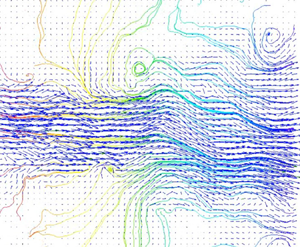Published online by Cambridge University Press: 25 March 2024

This work presents a simple analytical model for the streamwise and radial variations of turbulent kinetic energy dissipation in an incompressible round turbulent jet. The key assumptions in the model are: similarity in the axial velocity profile with a Gaussian shape, axisymmetric flow and the dominance of radial derivatives of the mean velocity over axial direction derivatives (similar to boundary layer theory). Initially, a simplified eddy-viscosity relation for turbulent stresses is derived using the algebraic stress model by Gatski & Speziale (J. Fluid Mech., vol. 254, 1993, pp. 59–78). Subsequently, with this eddy-viscosity relation, the relation for variations of turbulent kinetic energy dissipation is formulated using the conservation of turbulent kinetic energy. To extract the necessary constants of the model, experimental velocity statistics for round jets are obtained through particle image velocimetry measurements. The experimental results of the mean entrainment coefficient for turbulent jets are also analysed. When comparing the radial variation of turbulent kinetic energy dissipation from the model with experimental results at Reynolds number  $1.4\times 10^5$ and numerical results at Reynolds number
$1.4\times 10^5$ and numerical results at Reynolds number  $1200$ from the available literature, we observe a maximum error of
$1200$ from the available literature, we observe a maximum error of  $10\,\%$ and
$10\,\%$ and  $15\,\%$, respectively. Finally, using the validated model, we analyse the impact of mean velocity evolution parameters on the behaviour of turbulent kinetic energy dissipation and discuss its potential significance in future studies.
$15\,\%$, respectively. Finally, using the validated model, we analyse the impact of mean velocity evolution parameters on the behaviour of turbulent kinetic energy dissipation and discuss its potential significance in future studies.